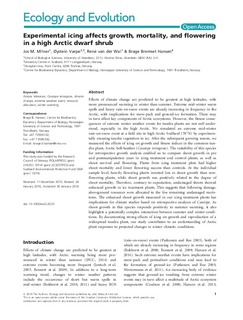| dc.contributor.author | Milner, Jos M | |
| dc.contributor.author | Varpe, Øystein | |
| dc.contributor.author | van der Wal, René | |
| dc.contributor.author | Hansen, Brage Bremset | |
| dc.date.accessioned | 2016-02-29T10:15:12Z | |
| dc.date.accessioned | 2016-03-17T12:29:32Z | |
| dc.date.available | 2016-02-29T10:15:12Z | |
| dc.date.available | 2016-03-17T12:29:32Z | |
| dc.date.issued | 2016 | |
| dc.identifier.citation | Ecology and Evolution 2016 | |
| dc.identifier.issn | 2045-7758 | |
| dc.identifier.uri | http://hdl.handle.net/11250/2382401 | |
| dc.description | | |
| dc.description.abstract | Effects of climate change are predicted to be greatest at high latitudes, with more pronounced warming in winter than summer. Extreme mid-winter warm spells and heavy rain-on-snow events are already increasing in frequency in the Arctic, with implications for snow-pack and ground-ice formation. These may in turn affect key components of Arctic ecosystems. However, the fitness consequences of extreme winter weather events for tundra plants are not well understood, especially in the high Arctic. We simulated an extreme mid-winter rain-on-snow event at a field site in high Arctic Svalbard (78°N) by experimentally encasing tundra vegetation in ice. After the subsequent growing season, we measured the effects of icing on growth and fitness indices in the common tundra plant, Arctic bell-heather (Cassiope tetragona). The suitability of this species for retrospective growth analysis enabled us to compare shoot growth in pre and postmanipulation years in icing treatment and control plants, as well as shoot survival and flowering. Plants from icing treatment plots had higher shoot mortality and lower flowering success than controls. At the individual sample level, heavily flowering plants invested less in shoot growth than nonflowering plants, while shoot growth was positively related to the degree of shoot mortality. Therefore, contrary to expectation, undamaged shoots showed enhanced growth in ice treatment plants. This suggests that following damage, aboveground resources were allocated to the few remaining undamaged meristems. The enhanced shoot growth measured in our icing treatment plants has implications for climate studies based on retrospective analyses of Cassiope. As shoot growth in this species responds positively to summer warming, it also highlights a potentially complex interaction between summer and winter conditions. By documenting strong effects of icing on growth and reproduction of a widespread tundra plant, our study contributes to an understanding of Arctic plant responses to projected changes in winter climatic conditions. | |
| dc.language.iso | eng | |
| dc.relation.uri | http://onlinelibrary.wiley.com/doi/10.1002/ece3.2023/full | |
| dc.rights.uri | http://creativecommons.org/licenses/by/4.0/ | |
| dc.title | Experimental icing affects growth, mortality, and flowering in a high Arctic dwarf shrub | |
| dc.type | Peer reviewed | |
| dc.type | Journal article | en_GB |
| dc.date.updated | 2016-02-29T10:15:12Z | |
| dc.source.journal | Ecology and Evolution | |
| dc.identifier.doi | 10.1002/ece3.2023 | |
| dc.identifier.cristin | 1340676 | |
| dc.relation.project | Norges forskningsråd: 223257 | |
| dc.relation.project | Svalbards miljøvernfond: 13/74 | |
| dc.relation.project | Norges forskningsråd: 216051 | |
| dc.description.localcode | Forlagets publiserte versjon (CC BY 3.0) | |

